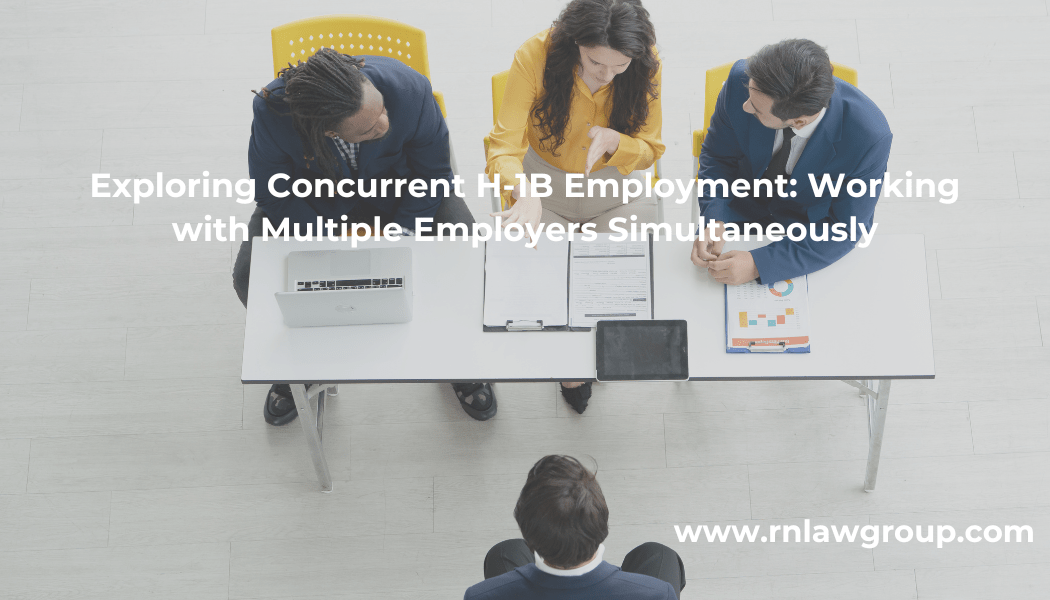
Exploring Concurrent H-1B Employment: Working with Multiple Employers Simultaneously
For professionals holding H-1B visas, the possibility of working for more than one employer at a time can offer valuable flexibility and security. Whether supplementing part-time hours, navigating industry shifts, or expanding professional experience, this option can provide meaningful advantages. However, the process can be complex. Below, we address frequently asked questions to clarify how concurrent H-1B employment works.
- What Is Concurrent H-1B Employment and How Does It Work?
If an individual is already maintaining valid H-1B status with Employer A, another employer (Employer B) may file a separate petition for concurrent employment. This new petition follows the standard H-1B process, including obtaining a certified Labor Condition Application (LCA) and submitting Form I-129 to USCIS, selecting “New concurrent employment.”
Based on H-1B portability provisions, the individual can begin working for Employer B once the new H-1B petition is received by USCIS. If USCIS later denies the petition, the individual must stop working for Employer B, but can continue with Employer A without disruption.
- Are the Requirements for Concurrent Employment Any Different?
No. The criteria for a concurrent H-1B position are the same as for any H-1B petition. The new employer must:
- Establish a valid employer-employee relationship.
- Comply with prevailing wage requirements.
- Demonstrate that the role qualifies as a specialty occupation requiring at least a bachelor’s degree in a related field.
The H-1B beneficiary must also meet qualifications through:
- A U.S. bachelor’s or higher degree relevant to the field,
- A foreign degree equivalent to a U.S. bachelor’s degree, or
- Equivalent experience.
If applicable, relevant licenses or certifications must also be submitted.
- Is There a Limit on the Number of Concurrent H-1B Employers?
There is no formal cap on how many employers an H-1B visa holder can work for concurrently. However, maintaining lawful H-1B status requires that the employment be feasible and credible in terms of hours worked and responsibilities fulfilled.
- Can You Hold Two Full-Time H-1B Jobs?
While technically possible, holding two full-time positions may raise concerns during petition review. Each petition must independently show that the individual can reasonably meet the full-time demands of both roles. In practice, one of the concurrent positions is often for part-time work.
Typically, full-time employment is defined as 40 hours per week (or no fewer than 35 hours, depending on industry norms).
- Can You Hold Two Part-Time H-1B Jobs?
Yes. H-1B workers may hold multiple part-time roles under concurrent petitions. Any position involving fewer than 35 hours per week generally qualifies as part-time.
- Can You Work Remotely for Multiple H-1B Employers?
Remote work is permitted, but each employer must accurately reflect the remote work location in their LCA and H-1B petition. LCA posting requirements must also be satisfied for the home office or alternate work location.
- When Can a Concurrent Petition Be Filed After Lottery Selection?
Once a foreign national’s H-1B registration is selected in the annual cap lottery, Employer A’s petition must be approved and H-1B status granted before a concurrent petition can be filed by Employer B. This status usually becomes effective on or after October 1 of the relevant fiscal year.
- Can a Foreign National Not Selected in the Lottery Work for a Cap-Exempt and Cap-Subject Employer Concurrently?
Yes. Cap-exempt entities can hire foreign nationals outside of the H-1B cap. After securing employment with such an employer, the individual may then pursue concurrent employment with a cap-subject employer.
However, continued eligibility to work for the cap-subject employer depends on ongoing employment with the cap-exempt organization. If that relationship ends, the concurrent role cannot continue without entering the H-1B cap process and being selected.
For more information on H-1B cap-exempt employment, visit: Not Selected the H-1B Lottery? Explore H-1B Cap-Exempt Employment as a Path Forward
Final Thoughts
Concurrent H-1B employment offers a unique path to flexibility and security for visa holders, but navigating the rules can be challenging. The best course of action often depends on the specific facts of each case. If you’re an H-1B professional or an employer exploring concurrent employment options, we recommend scheduling a consultation with one of the experienced business immigration attorneys at Reddy Neumann Brown PC. You can book an appointment here.
By: Krystal Alanis
Krystal Alanis is a Partner at Reddy Neumann Brown PC and manages the firm’s PERM Labor Certification Department, where she oversees all EB-2 and EB-3 employment-based green card matters. Krystal guides clients from a variety of industries through the maze of the PERM Labor certification process and has handled thousands of PERM applications throughout her career with Reddy Neumann Brown PC. Krystal also guides employers and individuals through the I-140 and Adjustment of Status process, and assists clients with temporary work visa petitions (e.g., H-1B, TN, L-1, E-2). With over 13 years of immigration experience, Krystal is able to advise her clients with confidence and recognize any potential pitfalls that may arise.

